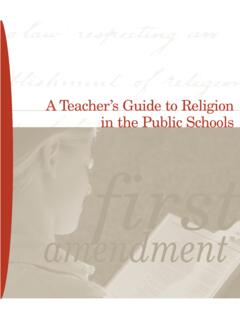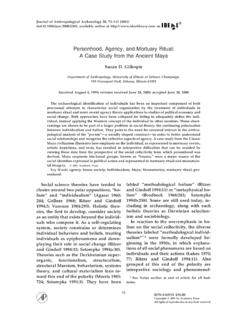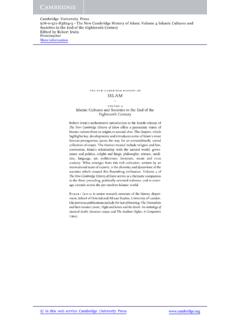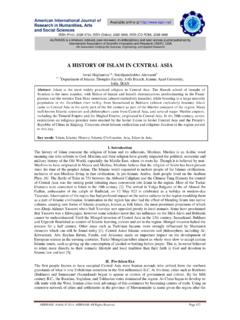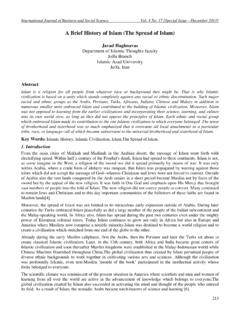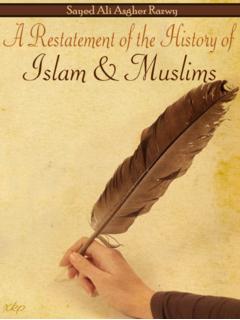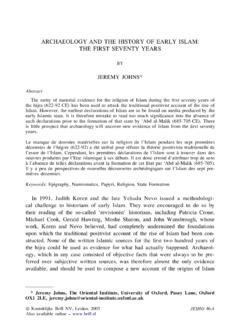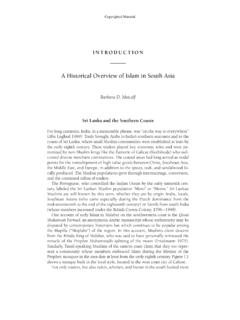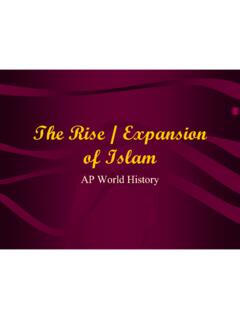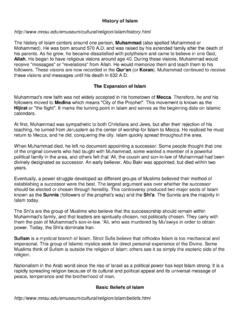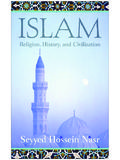Transcription of e Crusades and Islam - CLAS Users
1 Th e Crusades and IslamNorman HousleyUniversity of LeicesterAbstract Although crusading was not solely responsible for the deterioration of relations between Christianity and Islam in the central Middle Ages, it made a substantial and distinctive contribution toward it. Th e military needs of the crusader states placed the papacy in a situation of normative antagonism toward the Islamic powers of the Middle East. And while the primary motor of crusading was devotional and individual, the need to arouse people to take the Cross, as well as the creation of an image of the enemy, shaped a dominant picture of Islam , its founder, and adherents that was inaccurate, stereotypical, and lacking in humanity.
2 Th e twin processes of soul searching and information gathering that were stimulated by repeated defeat in the East had little effect on the negativity of this picture, because their purpose was not to mend relations between the faiths, but to revital-ize the Christian cause in order to achieve the recovery of Jerusalem. After the fall of the crusader states in 1291, the image of the enemy was transferred to the northern Turks; although it became much more complex and rounded, it retained a function that was over-whelmingly Euro-centric. Keywords Christianity, Islam , Crusades , Holy Land, Saracens, Turks At the close of the thirteenth century, following two centuries of Crusades against the Muslims, two events may be taken as representative of their impact on relations between Christianity and Th e first was the Mamluk capture of the port of Acre on 18 May 1291.
3 Th is was accompa-nied by the killing of thousands of soldiers and civilians and by the dis-patch into slavery of those who survived the massacre and were unable to Koninklijke Brill NV, Leiden, 2007 DOI: I am grateful to the students who took the 2005 Crayenborgh Course in the history Department at Leiden University and to colleagues in the Medieval Research Centre at the University of Leicester for their comments on this paper. Medieval Encounters 13 (2007) 189-208 MedievalJewish, Christian and Muslim CultureEncountersin Confluence and 13, 189ME 13, 1895/30/07 4:49:51 PM5/30/07 4:49:51 Th e second was the destruction in 1300 of Muslim Lucera, the town in southern Italy where the Staufen and Angevin rulers of the kingdom of Sicily had for about seventy years permitted large numbers of Muslims to live in peace.
4 In addition to economic motives, Charles II of Anjou was led to wipe out this thriving community, about twenty thousand strong, by the desire to please Pope Boniface VIII by conducting an ersatz crusade : he came from a family noted for its crusading commitments and exercised a dynastic claim to be king of In much the same way that Hein-rich Himmler, in 1943, hoped to be able to present Adolf Hitler on his birthday with a Warsaw that was Judenrein, Charles gave Boniface VIII, in the papal year of Jubilee, a vassal kingdom that was purged of the practice of Islam . At each end of the Mediterranean, large numbers of Christians and Muslims thus experienced death, dispossession, the breakup of their families, and a life of slavery because of their religious faith.
5 I start with the fall of Acre and the destruction of the colony at Lucera not just because I think it is important to remind ourselves of this subject s tragic human context but also because there is no point in disguising the fact that the effect of the Crusades on Christian-Muslim relations was pro-foundly destructive. Recent research and writing have emphasized just how negative that effect was on both sides of the religious divide. I will take the Muslim perspective first. Th e main lesson that we learn from Car-ole Hillenbrand s recent study of the Islamic sources on the Crusades is that the view that Muslims held of their Western opponents throughout the period of what one might term classical crusading (1095-1291) was characterized by generalized stereotyping, abuse, and contempt.
6 Even the so-called memoirs of the Arab nobleman Us mah ibn Munqidh, so often held up in the past as showing how easily the ice of religious antagonism melted in the sun of human contact and friendship, are viewed by Hillen-brand in a much less optimistic light; Us mah s underlying viewpoint, she emphasizes, was no different from that of his peers. It is true that there existed a small group, composed of both settlers and crusaders, who attracted the respect, even the admiration, of the Muslims, especially King Baldwin II, Richard C ur de Lion, Emperor Frederick II, and King Louis IX. And Muslim chroniclers could display admiration for the 2 Steven Runciman, A history of the Crusades , 3 vols.
7 (Cambridge: Cambridge Univer-sity Press, 1951-54), 3:417-20. 3 Julie Taylor, Muslims in Medieval Italy: Th e Colony at Lucera (Lanham, Md.: Lexington Books, 2003), 173-209. 190 N. Housley / Medieval Encounters 13 (2007) 189-208ME 13, 190ME 13, 1905/30/07 4:49:52 PM5/30/07 4:49:52 PM N. Housley / Medieval Encounters 13 (2007) 189-208 191courage, endurance, and faith of ordinary crusaders. But these were rare flashes of appreciation, and they were vastly outnumbered by assessments that were inherently hostile. Just as important was the fact that they were closed, in that occasional insights about the similarities between the two faiths, on such issues as pilgrimage and holy war, were simply not What is more remarkable than the negativity of the contemporary Mus-lim response is the fact that this response established the pattern for nearly all subsequent Islamic assessments of the crusading period.
8 Th e Crusades were depicted as the first major example of a belligerent Christian intru-sion into the Islamic heartland, the dar al- Islam , and later encounters between Islamic countries and European imperialism were configured in parallel terms. Th e jihad that was waged in the twelfth and thirteenth cen-turies for the recovery of Islam s lost holy places was both successful and glorious and it formed the obvious precedent for the several jihads preached in the nineteenth and twentieth centuries with the goal of expelling impe-rialist occupiers. We have become familiar in recent years with this repre-sentation of Islam as the victim of Western aggression in the constant assertions by al-Qa ida and Usama bin Laden that policy in the Mid-dle East is crusading and that opposition to it is a continuation of former jihads that were conducted in the name of the faith.
9 It has been well said that it is futile for Western commentators to respond to such a perspective by pointing out the numerous differences between the contemporary global scene and the age of the Crusades : what is at issue is the mindset of an Islamic group that perceives continuities in terms of what the Muslim world is experiencing at the hands of Much the same applies to recent scholarship on the Christian side of the divide. Until quite recently, there was general agreement amongst histori-ans on two issues that together had the effect of fracturing the uncompro-mising nature of the crusading stance. One was that raw antagonism based on religious difference did not long survive the experience of settle-ment in the East and that to a large degree the Franks who stayed in Pales-tine and Syria merged both with their physical environment and with the indigenous inhabitants.
10 Th e famed tolerance that William of Tyre 4 Hillenbrand, Th e Crusades : Islamic Perspectives (Edinburgh: Edinburgh University Press, 1999), esp. 257-327. 5 Jonathan Riley-Smith, Islam and the Crusades in history and Imagination, 8 Novem-ber 1898-11 September 2001, Crusades , 2 (2003): 151-67. On the jihad, see Richard Bonney, Jih d: From Qur n to bin L den (Basingstoke: Palgrave Macmillan, 2004). ME 13, 191ME 13, 1915/30/07 4:49:53 PM5/30/07 4:49:53 PM192 N. Housley / Medieval Encounters 13 (2007) 189-208displayed toward Islam and its rulers was viewed as a typical, albeit remark-ably eloquent, example of a general Th is led to friction when fresh waves of crusaders arrived, as the crusaders expected to encounter a scenario of total war between the two faiths.
